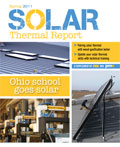
About the time when the Parkway Local Schools in Rockford, Ohio, were looking for ways to save energy in its K-12 school building, the federal government was providing grants for such projects through the economic stimulus package. The single, 245,000-square-foot building was built five years ago under a partnership with the Ohio School Facilities Commission and accommodates about 1,100 K-12 students.
During the planning process for the school’s construction, a geothermal system was considered, explainsGreg Puthoff, superintendent of the rural school. But the technology was “too young” to be used in that type of application, according to the state school commission. So instead a traditional forced-air heating system was installed. (Six months later, geothermal was approved for use in schools by the commission.)
In 2009, with the help ofGreg Smith, energy consultant and president of Energy Optimizers, USA, the school made some tweaks to the heating system, which did reduce energy consumption, as well as installed CO2 monitors. The school continued to look for ways to control its energy use, and that’s when the idea for using solar thermal was discussed.
Included in the federal government stimulus package of 2009 were energy-efficiency grants, specifically for using renewable energy technologies such as wind turbines and solar collectors. So Parkway Local Schools wrote up an $850,000 grant proposal and included all the energy-efficiency projects it wanted to do - from two solar thermal systems (one for space heating and the other for domestic hot water), to replacing all the light bulbs, to installing building systems management software, to re-doing the heating zones, to a wind turbine.
It took about a year to get the paperwork turned in and get it approved, Puthoff says. And until the grant was approved by the Ohio Department of Development, which runs the federal program in Ohio, the school district couldn’t make any improvements.
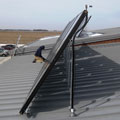
“We anticipated energy savings from the solar thermal system at $11,000 a year and estimated we would pay off our initial investment in about seven years,” he states. “However, when the estimates were made two years ago, the cost of natural gas was a lot higher. I informed the school board that we wouldn’t get quite the payback that we thought because natural gas is about half the price that it was in 2009. Payback might be nine years now. But after that, we’ll be saving money for the remaining life of the solar thermal system, about 15 years.”

System Performance
Smith, who started Energy Optimizers in 2009 to help K-12 school districts become more energy efficient and reduce costs, supervised the Parkway project. He works with solar manufacturers on project development and engineering, and school districts on project financing.One of Energy Optimizers’ strategic partners is Wat-Kem Mechanical, which installed the solar panels on the Parkway school building. Sixteen 4-foot by 8-foot solar panels manufactured by Bubbling Springs were installed on the building; it also made the heat dump system. Wat-Kem ran supply and return lines from the existing boiler to four new Rheem 120-gallon water storage tanks.
“From the new storage tanks, the glycol lines run through the control panel and pumps up to the solar collectors on the roof,” saysSheldon Ladd, project manager at Wat-Kem Mechanical and the solar panel installer at Parkway Local Schools. “For every storage tank, there are four collectors.”
Wat-Kem Mechanical’s service department handles residential, commercial, industrial and institutional customers. Its construction department works on hospital and university new construction and remodeling, which has helped the company average about $12 million a year over the last five or six years. The company has completed six solar jobs since last fall and is starting its seventh - all schools.
“Greg Smith offered Wat-Kem a chance to perform this work,” Ladd explains. “Our relationship with him and Energy Optimizers has brought us a different opportunity and a different challenge to us.”
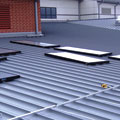
“If a school district is going to spend $1 million or $2 million, it’s going to want to know how the system is performing,” he says. “If it’s not performing correctly, you need to find out why and make changes.
“In all of our projects, we put in a three-year energy management plan. We assist the school districts and their staffs on how to use Energy Star, how to continue to track the savings. And we also try to tie natural gas and electric meters to the Internet so they can see in real time how much energy they are using and what the actual savings are.”
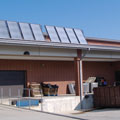
Made In The USA
The only obstacle during the project was the sourcing of the solar panels. The best bid for the solar panels came from a Canadian company, Puthoff states. However, the federal grant had a stipulation of sourcing material from U.S. manufacturers. And the definition of what was a U.S. product was not consistent among states.Even though about 86 percent of the solar panel parts were from the United States, the state of Ohio required that the entire product had to be assembled at a U.S. company. The school had to send back the panels and reorder from a Wisconsin company - Bubbling Springs, Smith says, which delayed the project about five months.
“Line set sizes were different, flows were different, so we had to change pumps to get the right flow rates,” he adds.
The maintenance room is closed off to students, so Wat-Kem was able to pour the cement pad and install the tanks and piping during the school day without disrupting students or staff. Piping installed overhead in the kitchen was installed over the school’s Thanksgiving break. Installation of the solar panels could be installed at any time because it didn’t disturb student or teacher activities.
“The installation process was managed real well by Wat-Kem Mechanical,” Puthoff says. “The installers were very cooperative.”
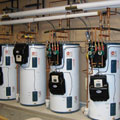
An Educational Experience
The project has only recently been completed, so Puthoff has no data regarding energy savings yet.“Besides the energy we’re saving for the planet and the money we’re saving for the district, our students are excited that we’re doing something ‘green’ and that they can see a system here that is helping the environment,” Puthoff remarks. The school sent two high-school science teachers and two middle-school science teachers for training and ordered curriculum material so students can learn more about how solar thermal works and the advantages of it.
Puthoff is quick to note that the school’s air-conditioning system, the most energy-efficient at the time the school was built, is unique. It consists of 12 large aluminum cylinders in the back of the school where, because of cheaper electric rates and the cool air temperatures, ice is made. During the day when cooler air is needed, air is blown the cylinders and circulated throughout the building.
Another eco-friendly project the school did over the summer (although it didn’t get federal funding for it), was replacing about 130 inefficient light fixtures in the building’s two gym areas and replacing 7,000 light bulbs with energy-efficient bulbs. Combined with the solar thermal system, the school hopes to save $37,000 a year in utility costs.
The school district purchased a “light-bulb eater,” which allowed it to recycle the old 7,000 light bulbs; the school makes it available to several area communities. And it gave away its remaining 300 to 400 standard light bulbs.
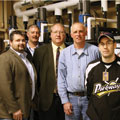
Future Of Renewable Energy
Ohio House Bill 264 funds public school energy-efficiency upgrades in the state, based on projected energy savings. As of November 2010, this funding is on hold, which could be bad news for rural school districts such as Parkway to upgrade existing heating equipment.“The continued support from Ohio tax dollars makes these projects affordable for small school districts,” Ladd says. “Once the energy savings are validated, then solar technologies will gain a foothold in common building practices in all types of buildings.”
Smith sees renewable energy gaining ground. And it’s becoming more prevalent in schools.
“I believe the K-12 market is perfect for renewable energy such as solar thermal,” he says. “If you can implement it successfully in one district, you can take that same model and implement somewhere else. We’ve worked with about 10 school districts in the last year to do solar thermal.”




